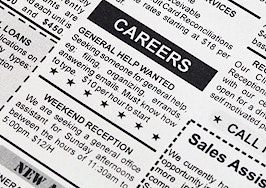- An artificial economic boom can be created via artificially low interest rates as a result of excessive malinvestments made by countless tricked entrepreneurs.
- As central banks have set interest rates low, at zero or negative, companies have adjusted their business models to highlight the speculative nature of their businesses to attract capital.
- Artificially low interest rates, rather than tricking entrepreneurs, trick markets and individuals. Consumers and homebuyers are fooled by artificially low interest rates as to the underlying health of the economy.
Reposted with permission from Smaulgld.com. Louis Cammarosano is a former executive at HomeGain.
There is an Austrian School of Economics tenet that states that one danger of artificially low interest rates is that they “trick” entrepreneurs into making “malinvestments” — investments that, in retrospect, don’t make any economic sense had the entrepreneur not been tricked by the “false signal” sent to him by the artificially low interest rates set by the central bank.
During a period of artificially low interest rates, the hapless entrepreneur, the Austrian theory goes, raises capital or invests in his business or a new business (the malinvestment) as if the health of the economy and his customers justify such investments. The entrepreneur projects that his future profits will be sufficient to repay the cost of his investment and to turn a profit.
According to Austrian economists, this scenario ends in tears for the entrepreneur when his business goes bust as the investment in his business was never justified and was encouraged by the artificially low-interest rates that attempted to mask the poor state of the underlying economy.
As such, an artificial economic boom can be created via artificially low interest rates as a result of excessive malinvestments made by countless tricked entrepreneurs. The Austrian economist solution to excessive malinvestments is to liquidate them while current central bank policy is to provide more stimulus and even lower interest rates to prop them up.
In “The dark side of artificially low interest rates,” we noted:
Austrian economists argue that artificially low interest rates fool entrepreneurs into making investments they otherwise would not make. We think, rather, many entrepreneurs understand the artificial nature of the low interest rates but nonetheless take advantage of them, hoping interest rates stay low long enough for their projects and profits to be realized.
Dispelling with the fiction of the tricked entreprenuer
To paraphrase Republican Presidential also-ran Marco Rubio: Let’s dispel with this fiction that today’s entrepreneurs are tricked in to making malinvestments, they know exactly what they are doing when they raise capital for their startups.
Many entrepreneurs are not looking to make their companies profitable; rather, they are looking to profit from their companies.
Artificially low interest rates send a green light to entrepreneurs to profit from reckless monetary policy. If the entrepreneur can raise private and public capital and sell a “growth story,” he can eventually sell a portion of his shares in the company at multiples far higher than the value of any salary or profits that may have been achieved in founding and running a profitable company.
[Tweet “Artificially low interest rates send a green light to entrepreneurs to profit from reckless monetary policy.”]
Over the past two decades, an increasing number of unprofitable (or barely profitable) companies have raised tens of millions of dollars (or more) in the public capital debt and equity markets, after having received almost equal amounts in the private capital markets.
Artificially low interest rates create an incentive for investors to speculate as savings offer little or no yield and in the case of negative interest rates, a loss on savings.
Today’s business models reflect today’s monetary policy: Vast sums of money can be made by losing money
The temporary periods of artificially low interest rates that formerly tricked entrepreneurs have turned into a permanent central bank policy that entrepreneurs knowingly exploit.
Low, zero and/or negative interest rates are now permanent features of central bank policies. Today’s entrepreneurs learn that artificially low, zero or negative interest rates drive capital away from fixed income investment vehicles in search of higher yields.
Some of that money finds its way into speculative companies like theirs.
As central banks have set interest rates low, at zero or negative, companies have adjusted their business models to highlight the speculative nature of their businesses to attract capital. Instead of highlighting profit potential, they emphasis non-financial metrics like customer growth or website visitors (and when reporting financial metrics, they emphasize non-Generally Accepted Accounting Principles (GAAP) metrics). In order to achieve these metrics, companies may discount their products and services heavily, spend excessively on sales and markets or give away their products and services.
On Smaulgld.com, we have noted that a low interest rate environment may encourage companies to offer steep discounts on its products and services to drive customer growth to attract speculative capital. A zero-interest-rate environment many encourage companies to offer free products and services while negative interest rates may eventually mean companies start paying customers to use their products and services in order to generate customer growth.
Companies were once valued on the basis of their revenue and profit growth and potential. Since the mid to late 1990s, however, many Internet, biotech and social media companies have raised public capital, been listed on major stock exchanges, done large secondary offerings, seen their stock prices rise, all while not showing a profit. Showing revenue and customer growth — that can be obtained by heavy investment in sales and marketing — instead of profits is what attracts capital in today’s speculative markets driven by artificially low interest rates.
Increasing customer and or revenue growth becomes paramount for speculative companies even if such growth is not profitable or does not represent sustainable market share increases.
The sagacious entrepreneur, however, knows that by promising “game-changing” technology or the potential of building a huge “installed customer base” that he has a better chance of raising speculative capital (malinvestment) than by showing a slow growth profitable business plan. A well capitalized speculative company can lose money for years while growing eyeballs, customers and revenues as long as they continue to “innovate” and learn to “delight” their customers with a “great consumer experience” while building out their “ecosystems.”
The Zillow example: Making money by losing money
Zillow is a real estate marketing site that displays home and apartment listings and other information related to the housing market. Zillow was founded in 2005 and since then has raised over $528 million ($87 million prior to going public), generated more than a billion dollars in revenue and lost more than $250 million.
Zillow went public in 2011 at $20 a share and market capitalization of about $700 million. The share price of Zillow hit an all-time high of about $144 in 2014. At its peak in 2014, Zillow had a market capitalization of about $6 billion.
Zillow has been a growth story since its inception. It has grown organically through sales and marketing and investment in technology. It has raised capital on its growth story and reinvested it in more sales and marketing and on acquisitions, often of other unprofitable companies with similar growth stories, like its acquisition of Rent Juice for $40 million. Zillow also has used its highly priced shares to acquire other unprofitable companies, like competitor Trulia in 2014.
Here is a chart showing the amount of capital Zillow has raised while touting its (unprofitable) growth story:

Zillow raised $87 million before raising capital in the public markets in 2011.
Losses growing? Liquidate? No — raise more capital!
The Austrian economist view of the business cycle advocates liquidation of unprofitable ventures. In an environment of permanent artificially low interest rates the smart entrepreneur that is losing money raises more capital during the boom to ride out the bust in anticipation of the next artificial central bank induced boom that will come from further stimulus or lowering of interest rates.
During this period of capital raising the company never makes a profit, but its officers, directors and shareholders make money from the company by pocketing massive stock market gains.
Losses are not a bug, they are a feature
Artificially low interest rates may not trick entrepreneurs, but they do make a lack of profits less of an issue and indeed somewhat of a feature.
The chart below shows how Zillow’s revenues and losses grew over its 11-year history.

Zillow’s market capitalization grew along with revenue … and losses.
The $70 million trick
Zillow has not generated any meaningful profits in its entire history but has generated stunning returns for its original investors, officers and directors and many public shareholders. The CEO at Zillow has benefited handsomely via the growth of his stock options that he has exercised and sold over the years while the company was reporting increasing revenues and losses.
The Zillow CEO sold over $70 million worth of Zillow shares since 2011.

Zillow’s CEO profited from the “trick” of generating growth and losses in an artificially low interest rate environment.
Losses can mean gains in an artificially low interest rate environment
Pursing a speculative growth strategy funded by private and public capital clearly paid off for Zillow and its shareholders in stock gains even though the company lost increasing amounts of money.
Indeed, had Zillow focused on trying to turn a profit, the speculative element of its share price would have vanished and with it, its multi-billion-dollar market cap.
Is anyone tricked by artificially low interest rates?
Investors, homebuyers and society are tricked.
Artificially low interest rates, rather than tricking entrepreneurs, trick markets and individuals. Consumers and homebuyers are fooled by artificially low interest rates as to the underlying health of the economy. Artificially low interest rates help boost stock and real estate prices, which create a “wealth effect” so that people feel richer as the value of their homes and stock portfolios rise.
The wealth created from rising home and stock prices, like the interest rates that engendered their increases, is artificial. In an artificially low interest rate environment, stocks rise ahead of their profit growth, or as we have seen in the case of Zillow, in spite of any profits. Homes that undergo no improvements increase in value when rates are artificially low, merely by remaining idle.
Artificially low interest rates are politically correct
Central bankers are appointed by governments that don’t want its citizens to think the economy is faltering under their watch. Central banks, therefore, are inclined to institute loose monetary policies to give the illusion of an improving economy through rising asset prices.
Rising asset prices can trick society into thinking the economy is doing well as asset prices rise, even though there is not a corresponding increase in economic activity or productivity. Unprofitable companies that are well capitalized can hire many workers, which adds to the illusion that the economy is doing well.
Rising share prices of unicorn stocks like Zillow give the false impression that companies like it are doing well and therefore the economy as a whole is also doing well. Employees who work at unprofitable companies with multi-billion-dollar market capitalizations are also fooled into thinking that the high salaries and lucrative stock options they draw will be sustainable and therefore they will be able to pay inflated real estate prices and rents.
Many employees are no doubt unaware that the dollars they receive in compensation are not derived from their company’s profits but from equity raised in a speculative environment caused by artificially low interest rates.
With the onset of negative interest rates, entrepreneurs will have projected correctly in anticipating that interest rates would stay long enough for their projects to be completed — i.e., their share prices have stayed elevated long enough to cash out.
Do profits matter?
Apparently not. At least, not as long as central banks can manipulate rates ever lower and provide increasing amounts of stimulus.
The next “trick” in the central banks’ tool kit to support artificially low and negative interest rates is the removal of cash from circulation, either through the elimination of large denominated bills or banning cash entirely.
Central planners believe that a cashless society will, among other things, discourage the hoarding of cash and encourage people to spend what ever digital entrees they may have in their bank accounts, thus stimulating the economy, or to “invest” their digital money in the stock market. A negative interest rate/cashless society might act to further solidify the market capitalizations of unprofitable unicorn stocks like Zillow.
Who’s kidding whom?
Although the Austrian economists are correct that artificially low interest rates create malinvestments in that they encourage investment in non profitable ventures, these ventures, nevertheless, can provide entrepreneurs and their shareholders with oversized returns for years.
But entrepreneurs have not been tricked; the joke is on us.
Louis Cammarosano is the author of Smaulgld, a blog that provides finance, economics and real estate market analysis, and marketing strategies and tips for real estate professionals.




